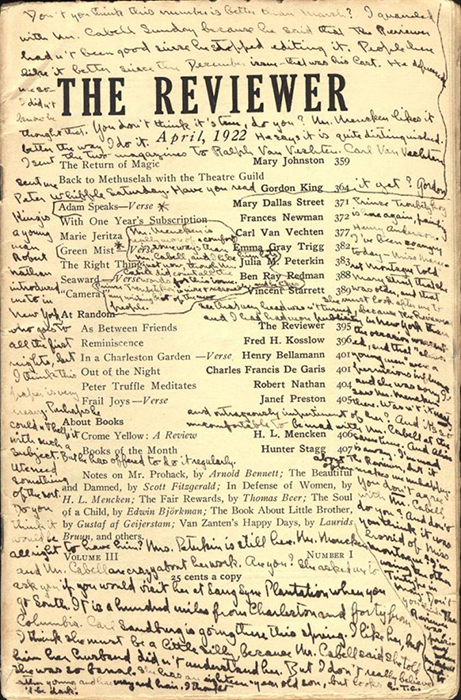
Special Collections and Archives, VCU Libraries
The Reviewer was a literary magazine published from 1921 until 1925. Founded by Emily Tapscott Clark, Hunter Stagg, Mary Dallas Street and Margaret Freeman, The Reviewer was based in Richmond, Va., with offices at 206 North Harrison Street. Emily Clark was the magazine’s editor. Over the course of its 35 issues, The Reviewer published both established and new authors. The journal became important to Richmond intellectual life and added momentum to the larger Southern Renaissance. Its first issue sold for fifteen cents.
With an open editorial policy, The Reviewer became a forum existing between the Old South and the New as it made the case for Southern writers. Clark wrote, “We are here to discover something–that is our sole excuse for being here at all” (March 1922).
The Southern Renaissance was a literary movement in the 1920s and 1930s in response to criticism from writers such as H. L. Mencken (“The Sahara of the Bozart,” New York Evening Mail, 1917) who declared the South provincial and intellectually barren. Mencken wrote, “Once you have counted James Branch Cabell (a lingering survivor of the ancien regime: a scarlet dragon-fly imbedded in opaque amber) you will not find a single Southern prose writer who can actually write.”
Writers of the Southern Renaissance left behind sentimental Lost Cause narratives, such as those made famous by Thomas Nelson Page, and took as their new themes the burden of the South’s history and its conservative culture. These writers were experimental and brought new narrative techniques to literature.
Beginning in October 1921, James Branch Cabell served as a three-month guest editor for the second volume. Emily Clark describes this period in “The Case of Mr. Cabell vs. the Author of the Biography” (Virginia Quarterly Review, Summer, 1929).
For three months, October, November, and December, 1921, it must be told for the benefit of Cabell collectors, he edited the magazine single-handed, to show four awed editors just how editing could and should be done. He proved, in addition to brilliant editorial gifts, to be an expert make-up man, for the pages of the magazine never, before or since, were shaped with such exquisite precision.
Issues under Cabell’s oversight included established writers such as Ellen Glasgow, Mary Johnston, Robert Nathan and John Galsworthy along with younger southerners including Josephine Pinckney, Frances Newman, Paul Green and DuBose Heyward (Ben Stark Spangler in The Companion to Southern Literature: Themes, Genres, Places, People… ed. Joseph M Flora et al., p.736).
Beginning with “A Postscript” in the April 15, 1921 issue, Cabell also contributed to The Reviewer under his own name and various pseudonyms, including Burwell Washington, Henry Lee Jefferson and Claiborne Hauks Anderson. (See Thorne and Lloyd, An Illustrated Bibliography of Works By and About James Branch Cabell) In typical Cabell fashion, most of these short works would later become part of Cabell’s books.
Emily Clark left The Reviewer in 1924. Her humorous farewell noted, “We have proved that a successful Southern magazine is possible” and “We have made many people exceedingly angry and we have encountered blank indifference from an even larger number.” Soliciting material to publish and funds to support the magazine were a continuous challenge, but Clark declared, “We have also had an enormous amount of fun. And we are entirely without regret.”
Issues of The Reviewer from 1921 to 1925 may be read online at HathiTrust.org. See also this view of 1921 to 1922.
Correspondence between Cabell and numerous people associated with The Reviewer may be found in the James Branch Cabell collection at VCU Libraries Special Collections and Archives.

Special Collections and Archives, VCU Libraries